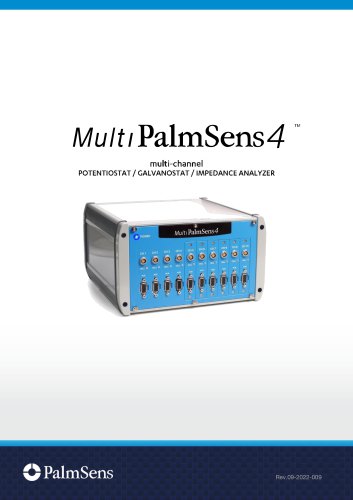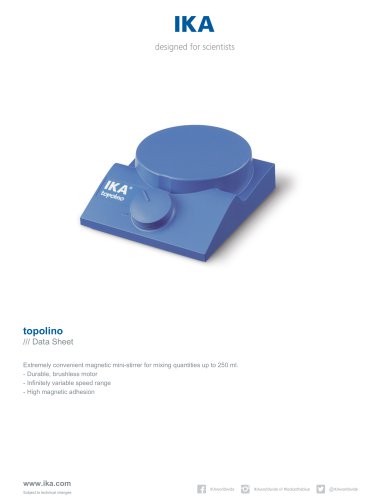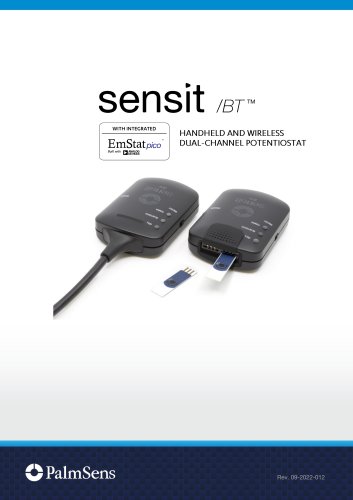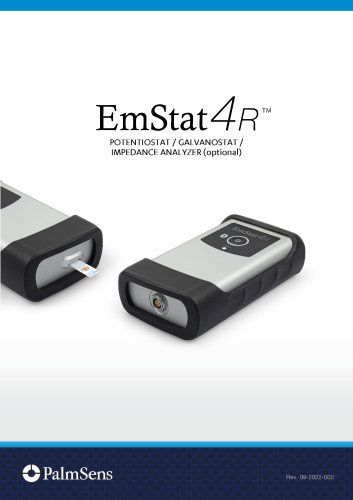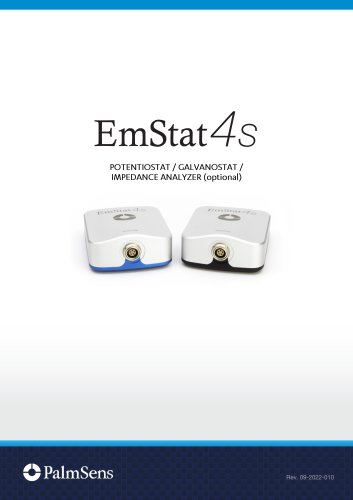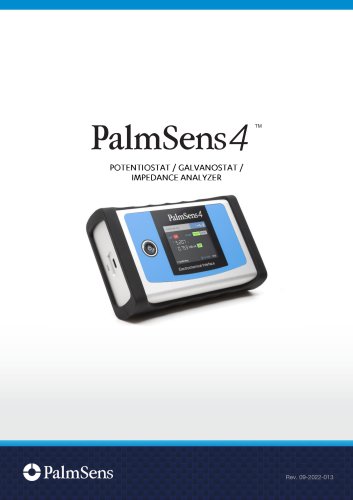
Catalog excerpts
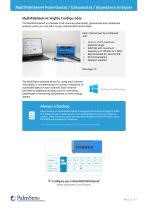
The MultiPalmSens4 is a flexible multi-channel potentiostat, galvanostat and impedance analyzer which you can tailor to your requirements and budget. Each channel can be configured with: ▪ ▪ ▪ ▪ ▪ ±5 V or ±10 V maximum potential range EIS/FRA with maximum frequency of 100 kHz or 1 MHz Bipotentiostat for second WE iR-Compensation Galvanic isolation The MultiTrace software allows for using each channel individually or simultaneously or running a sequence of automated tasks on each channel. Each channel provides an additional auxiliary port for controlling peripherals or monitoring temperature...
Open the catalog to page 3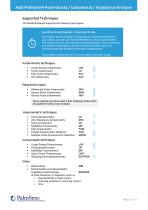
The MultiPalmSens4 supports the following techniques. By enabling synchronization of channels and adjusting the setup of your cables, you can use the MultiPalmSens4 as a polypotentiostat. This means you can use multiple working electrodes, one counter and one reference electrode in the same cell at the same time. Your working electrodes all perform the same measurement. Techniques marked with an can be used in Synched mode. Linear Sweep Voltammetry Cyclic Voltammetry Fast Cyclic Voltammetry AC Voltammetry Differential Pulse Voltammetry Square Wave Voltammetry Normal Pulse Voltammetry These...
Open the catalog to page 4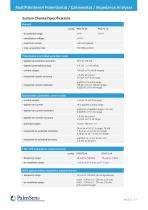
General config Potentiostat (controlled potential mode) ▪ applied dc-potential resolution ▪ applied potential accuracy ▪ measured current accuracy ▪ measured current resolution 0.005% of current range (18-bit, 5 fA on 100 pA range) 0.0025% of 10 mA range Galvanostat (controlled current mode) ▪ current ranges ±6 x applied current range ▪ applied dc-current resolution 0.0076% of applied range (<10 mA) 0.0038% of 10 mA range ▪ applied dc-current accuracy ▪ measured dc-potential resolution 78 µV at ±10 V (1 V range, 18-bit) 7.8 µV at ±1 V (100 mV range) 0.78 µV at ±0.1 V (10 mV range) ▪...
Open the catalog to page 5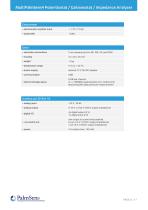
Electrometer ▪ electrometer amplifier input Other ▪ electrode connections external 12 V AC/DC adapter ▪ internal storage space 8 GB per channel or +/- 800000 measurements incl. method info (assuming 200 data points per measurement) Auxiliary port (D-Sub 15) ▪ analog input 0-10 V, 12-bit (1 kOhm output impedance) 4x digital output (5 V) 1x digital input (5 V) raw output of current and potential E-out ±10 V (1 kOhm output impedance) i-out ±6 V (1 kOhm output impedance)
Open the catalog to page 6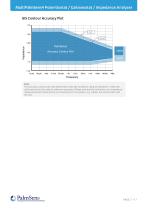
Note The accuracy contour plot was determined under lab conditions using the standard 1 meter cell cable and should be used for reference purposes. Please note that the true limits of an impedance measurement are influenced by all components in the system, e.g. cables, the environment, and the cell.
Open the catalog to page 7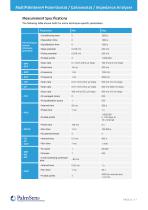
The following table shows limits for some technique-specific parameters. Parameter All techniques (unless otherwise specified) ▪ N data points ▪ Pulse time ▪ Level switching overhead time
Open the catalog to page 8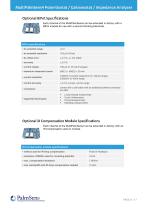
Each channel of the MultiPalmSens4 can be extended in-factory with a BiPot module for use with a second Working Electrode. BiPot specifications ▪ dc-potential range ▪ maximum measured current 0.005% of current range (5 fA on 100 pA range) 0.0025% of 10mA range comes with a cell cable with an additional (yellow) connector for WE2 Linear Sweep Voltammetry Cyclic Voltammetry Chronoamperometry Multistep Amperometry Each channel of the MultiPalmSens4 can be extended in-factory with an iR Compensation add-on module. iR Compensation module specifications ▪ method used for iR-drop compensation...
Open the catalog to page 9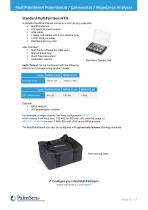
A standard MultiPalmSens4 comes in a soft carrying case with: ▪ MultiPalmSens4 ▪ 12V external power supply ▪ USB cable ▪ 1 meter cell cables with 2 mm banana pins ▪ 4 croc clips per cable ▪ PalmSens Dummy Cell Also included: ▪ MultiTrace software (on USB stick) ▪ Manual (hardcopy) ▪ Quick Start document ▪ Calibration reports PalmSens Dummy Cell can be configured with the following options and corresponding product codes: code: Potential range Optional: o BiPot module o iR Compensation module For example, a single channel can have configuration MPS4.F1.05 which means it will have max. 100...
Open the catalog to page 10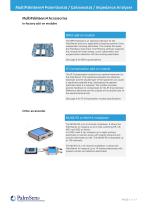
BiPot add-on module The BiPot Module is an optional extension for the PalmSens4 and is for applications requiring control of two independent working electrodes. The module fits inside the PalmSens instrument. The PSTrace software supports this module for linear sweep, cyclic voltammetry and amperometric detection with two working electrodes. See page 9 for BiPot specifications iR Compensation add-on module The iR Compensation module is an optional extension for the PalmSens4. The resistance between the reference electrode and the double layer of the specimen can cause a significant...
Open the catalog to page 11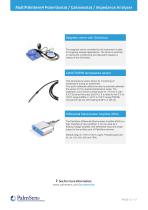
Magnetic stirrer with Switchbox The magnetic stirrer controlled by the instrument is ideal for stripping analysis applications. The stirrer is switched on during the conditioning and deposition stages by means of the Switchbox. LM35/TMP36 temperature sensor This temperature sensor allows for monitoring of temperature during an experiment. Two point calibration allows the user to precisely calibrate the sensor for the required temperature range. The calibration curve shows a linear slope of +10 mV/°C with 0.5°C Ensured Accuracy (at 25°C). It is rated for full 2°C to 150°C range (LM35) or...
Open the catalog to page 12
The MultiPalmSens4 comes with MultiTrace for Windows. MultiTrace allows the instrument to be controlled in two different modes: Individual and Simultaneous channel control mode. This mode can be selected when in the opening screen of MultiTrace. Individual Mode: where each channel can run a measurement or script independently from the other channels. Simultaneous Mode: where all channels run the same measurement. The individual mode gives an overview of all channels. Each channel can be selected separately and can run a measurement independently in parallel with other channels. You can also...
Open the catalog to page 13
The individual mode also supports the option to run a sequence of measurements on a specific channel by using Scripting. Such a sequence can include different techniques and provides control commands for manual cell control or digital input or output lines. In the Simultaneous Mode the MultiPalmSens4 works with all channels running the same measurement in parallel at the same time. There is only one active method in the Method Editor which is started on all channels simultaneously upon start. All results are presented as overlays in the same plot. This panel in the main screen contains a...
Open the catalog to page 14
